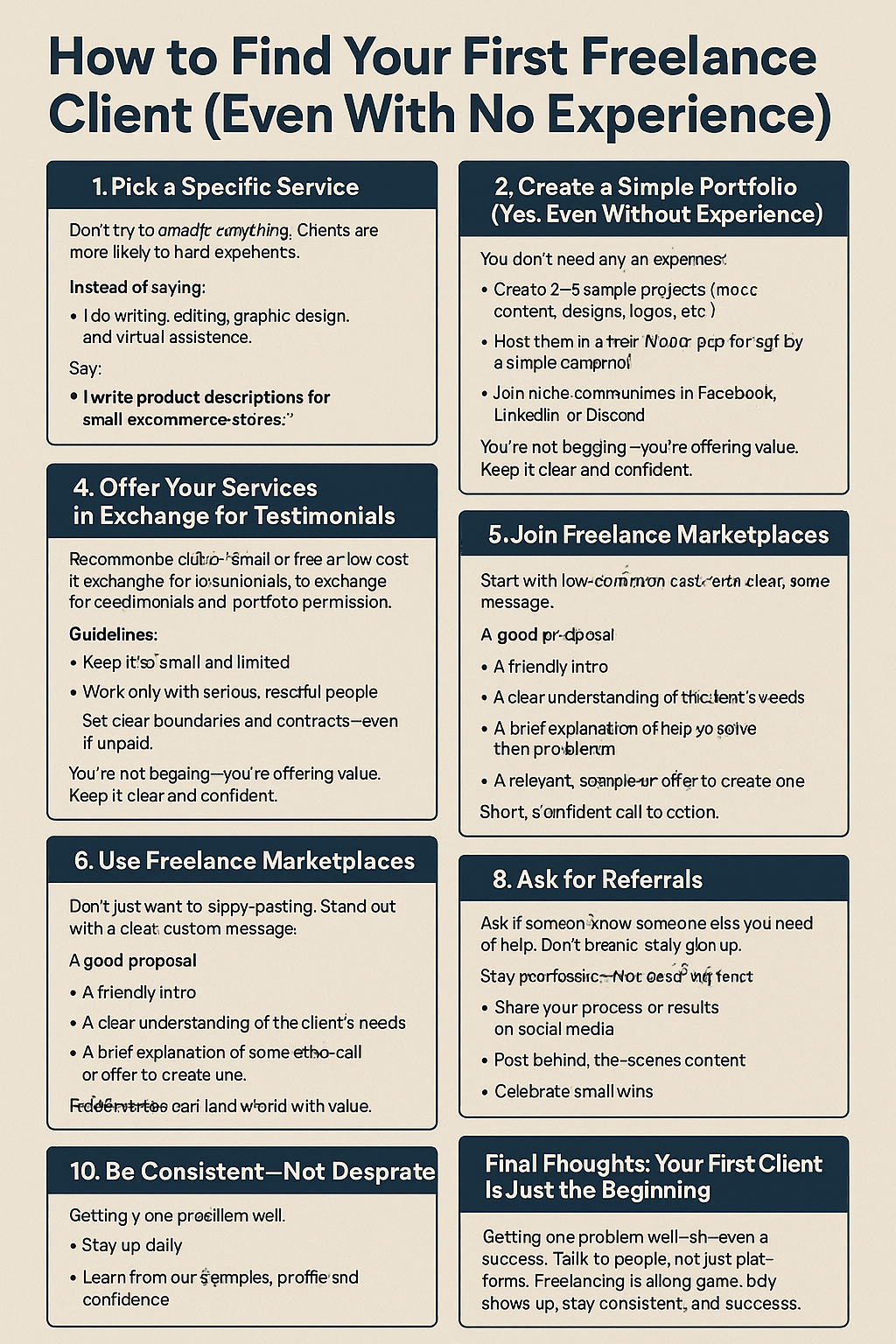Getting your first freelance client can feel like the hardest part of your journey. You don’t have testimonials. You don’t have a portfolio. Maybe you don’t even know where to start. But every successful freelancer was once where you are. In this article, you’ll learn practical, step-by-step methods to land your first freelance client, even if you’re just getting started.
Step 1: Pick a Specific Service
Don’t try to offer everything. Clients are more likely to hire you if you focus on solving one specific problem.
Instead of saying:
“I do writing, editing, graphic design, and virtual assistance…”
Say:
“I write product descriptions for small e-commerce stores.”
Start narrow—specialization builds trust faster.
Step 2: Create a Simple Portfolio (Yes, Even Without Experience)
You don’t need client work to build a portfolio. You just need examples of what you can do.
How:
- Create 2–3 sample projects (mock content, designs, logos, etc.)
- Host them in a free Notion page, Google Drive folder, or a simple Carrd site
- Include a short explanation of each sample (what it is and why it works)
Make it clean, relevant, and focused on your niche.
Step 3: Reach Out to Your Existing Network
Your first client might already know you—but they need to know you’re available.
What to do:
- Post on your personal social media
- Email former coworkers, classmates, or friends
- Tell local businesses you’re offering freelance services
- Join niche communities on Facebook, LinkedIn, or Discord
You’re not begging—you’re offering value. Keep it clear and confident.
Step 4: Offer Your Services in Exchange for Testimonials
When starting out, consider doing 1–2 small projects for free or low cost—in exchange for a strong testimonial and permission to use the work in your portfolio.
Guidelines:
- Keep it small and limited
- Work only with serious, respectful people
- Set clear boundaries and contracts, even if unpaid
Use these projects to practice and prove your reliability.
Step 5: Join Freelance Marketplaces
Even beginners can get hired on platforms like:
- Upwork – Start with low competition categories
- Fiverr – Create specific service “gigs”
- PeoplePerHour – Great for hourly or small jobs
- Workana – Popular in Latin America
- Contra – Portfolio-based platform with no fees
Focus on clear proposals, fast responses, and consistent activity.
Step 6: Create a Strong Proposal Template
When you apply for jobs, don’t just copy-paste. Stand out with a clear, custom message.
A good proposal includes:
✅ A friendly intro
✅ A clear understanding of the client’s needs
✅ A brief explanation of how you’ll solve their problem
✅ A relevant sample or offer to create one
✅ A strong, confident call to action
Short, simple, and client-focused wins every time.
Step 7: Use Cold Outreach (Smartly)
You don’t need to wait for job posts. Reach out to businesses or solopreneurs you’d love to work with.
How:
- Find small businesses with weak websites, content gaps, or design needs
- Craft a short, helpful message
- Offer one tip or suggestion
- Ask if they’d like help improving it
Example:
“Hi Sarah, I noticed your product descriptions could benefit from more SEO. I’m a freelance copywriter who helps brands like yours drive more traffic and conversions. Would you be open to a quick chat?”
Don’t spam. Personalize and lead with value.
Step 8: Ask for Referrals
If someone says no—or if you finish a test project—ask if they know someone else who might need your help.
People love helping freelancers who are professional and kind. Referrals can land you work faster than any platform.
Step 9: Build Social Proof (Fast)
Social proof builds trust—even if you’re new.
How:
- Share your process or results on social media
- Post behind-the-scenes content (“writing product descriptions for a new Shopify store”)
- Celebrate small wins (“Just sent my first invoice!”)
Over time, people will see you as someone who’s serious and capable.
Step 10: Be Consistent—Not Desperate
The first client may take days, weeks, or even a month to find. Don’t panic. Stay professional, keep showing up, and improve your outreach as you go.
✅ Show up daily
✅ Pitch consistently
✅ Learn from every “no”
✅ Keep improving your samples, profile, and confidence
Freelancing is a long game. Every message you send is practice—and every day you take action is progress.
Final Thoughts: Your First Client Is Just the Beginning
Getting your first freelance client feels huge—and it is. But it’s also just the start of something bigger.
Focus on:
- Solving one problem well
- Showing your value with real examples
- Talking to people, not just platforms
You don’t need years of experience to be valuable. You just need to show up, stay consistent, and serve your first client like a pro.

